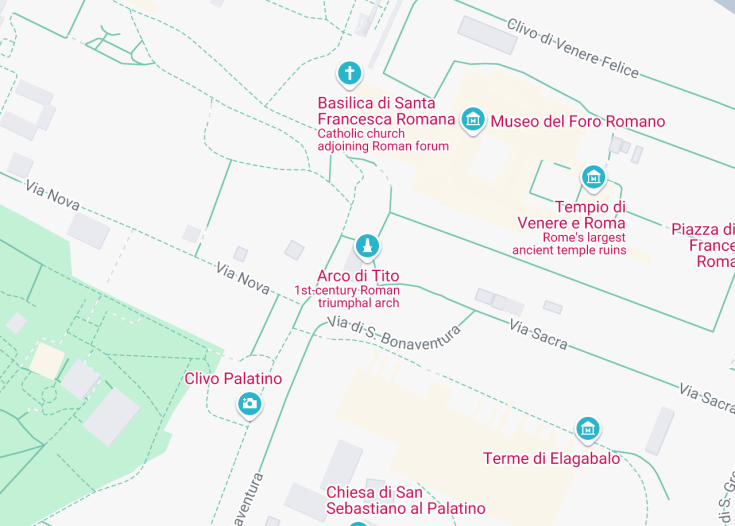The Arco di Tito, or Arch of Titus, is a remarkable ancient Roman monument located on the Via Sacra in Rome, Italy. Constructed circa 81 AD, this honorific arch commemorates the deification of Emperor Titus and celebrates his victory in the Jewish War. Renowned for its stunning reliefs depicting the spoils of Jerusalem, it stands as a symbol of Roman triumph and artistic achievement, attracting countless visitors each year.
For potential visitors to the Arch of Titus, it is advisable to explore the site early in the morning or late in the afternoon to avoid the crowds. This timing allows for a more intimate experience with the intricate reliefs and impressive architecture.
Those planning a visit should consider combining their trip to the Arco di Tito with a tour of the surrounding Palatine Hill and Roman Forum. This approach provides a comprehensive understanding of ancient Roman history and its architectural wonders, enriching the overall experience.
Exploration of the Arch of Titus in Rome, Italy
The Arch of Titus is an exemplary honorific arch, erected in approximately 81 AD by Emperor Domitian in honor of his deceased brother Titus. This remarkable structure is renowned for its architectural innovation and its rich historical significance. The arch features a single opening framed by engaged columns with a composite style capital, indicative of a shift from earlier Roman architectural practices towards a more monumental aesthetic. Its overall dimensions are impressive, standing at a height of 15.4 meters, a width of 13.5 meters, and a depth of 4.75 meters.
The interior archway showcases an intricately coffered ceiling, with the central relief depicting the apotheosis of Titus, symbolizing his deification. Two prominent relief panels enhance the arch’s message; one illustrates the triumphant procession following the siege of Jerusalem in 70 AD, featuring the looted menorah and sacred vessels from the Second Temple, while the other portrays Titus in his victory chariot, flanked by allegorical figures of Valor and Victory.
This architectural masterpiece not only represents Roman religious and cultural values but also serves as a pivotal point in art history where human and divine imagery coalesce. Its enduring legacy influenced numerous later triumphal arches, establishing a template that has echoed throughout Western architectural history.
History
1st Century AD: Construction and Purpose
The Arch of Titus was constructed shortly after the death of Emperor Titus in 81 AD. It was commissioned by his brother Domitian to honor his legacy and commemorate the Roman victory over Judaea. The arch signifies the deification of Titus and serves as a powerful symbol of Rome’s military triumphs.
Medieval Period: Fortification and Transformation
During the Middle Ages, the arch underwent significant alterations, being incorporated into a fortified structure by the Frangipani family. They added a second story to the vault, which altered its original aesthetic and function. This medieval adaptation also included a roadway that was lowered, exposing the arch’s foundations.
19th Century: Restoration Efforts
In the early 1800s, substantial restoration work commenced under the direction of architects Raffaele Stern and Giuseppe Valadier, aiming to restore the arch to its former glory. This initiative included reintroducing travertine and remodeling some decorative elements, ensuring that both the original design and subsequently added features could be distinguished.
Experiencing the Arch of Titus in Rome
Visitors to the Arch of Titus will find a wealth of historical context surrounding this monument. Walking through the arch allows one to appreciate the intricate reliefs depicting Titus’s triumph. The nearby area often features informational plaques that provide insights into the historical events commemorated by this landmark. Furthermore, the arch stands as a perfect backdrop for photography, imbuing visitors with the grandeur of ancient Rome.
Iconic Depiction of Jewish Artifacts
The Arch of Titus is renowned for its detailed sculptural relief that prominently features the Menorah, a seven-branched candelabrum. This depiction is not merely ornamental but resonates with profound historical meaning, representing the treasures of the Second Temple taken by the Romans after the fall of Jerusalem. The Menorah has since become a symbol of Jewish identity and resilience, echoing the enduring cultural heritage that thrives beyond its ancient origins.
General informations
Location
The Arco di Tito, or Arch of Titus, is situated on the southeastern side of the Roman Forum, specifically along the historic Via Sacra. This grand structure lies nestled among the ancient ruins of Rome, close to significant landmarks like the Colosseum and the Palatine Hill.
Address:
Via Sacra, 00186 Roma RM, ItalyVisiting Information
The arch is accessible to the public and can be visited freely at any time of the day. However, the best experience is recommended in the early morning or late afternoon when the lighting enhances the details of its intricate sculptures.
How to Reach the Arch of Titus
Car
The Arch of Titus is easily reachable by car, although parking can be limited in the busy areas of Rome. It is advisable to use public transportation due to heavy traffic and narrow streets.
| Route | Distance | Travel time |
|---|---|---|
| From Roma Termini Station | 1.6 miles (2.5 km) | 10 minutes |
| From Vatican City | 3 miles (5 km) | 25 minutes |
| From Ciampino Airport | 12 miles (20 km) | 40 minutes |
Public Transport
The Arch of Titus is well connected by public transport options, including buses and metro. The nearest metro stop is Colosseo (Line B), just a short walk from the arch.
| Route | Distance | Travel time |
|---|---|---|
| From Roma Termini Station (Metro) | 1.3 miles (2 km) | 15 minutes |
| From Vatican City (Bus) | 3.1 miles (5 km) | 30 minutes |
| From Ciampino Airport (Bus + Metro) | 12 miles (20 km) | 1 hour |
Accessibility and Limitations
The Arch of Titus is located in a busy historical area, and while it is largely accessible, visitors should be aware of cobblestone walkways that may pose challenges for those with mobility issues.
Accessibility
Limitations
- Accessibility may be difficult for visitors with mobility impairments due to cobblestones and uneven ground.
- The area can become crowded, particularly during peak tourist seasons.
- Limited seating is available near the arch for resting.
Notes to visitors
- Admire the intricate reliefs and sculptures on the arch closely to appreciate Roman artistry.
- Consider visiting early in the morning to avoid crowds.
- Be prepared for possible restrictions on large bags or backpacks in the vicinity as a security measure.
Common questions
What can I see at the Arco di Tito in Rome?
At the Arco di Tito, visitors can appreciate its impressive architectural design and its rich sculptural elements that narrate significant historical events.
The arch is adorned with two notable relief panels that depict the triumph of Emperor Titus following the conquest of Jerusalem in 70 AD.
On the north side, you will find the relief showing Titus in his triumphal quadriga, crowned by Victory, emphasizing his military achievements.
Meanwhile, the south side illustrates the spoils taken from the Temple in Jerusalem, prominently featuring the Menorah, a seven-branched candelabrum among other sacred artifacts.
The arch’s inner vault is beautifully decorated with coffering, and the soffit features a relief illustrating the apotheosis of Titus, symbolizing his divine status after death. All these elements craft a visual story of victory and divine favor in ancient Rome.
What is the significance of the decoration on the Arco di Tito?
The decorations on the Arco di Tito hold profound significance, both culturally and historically. They serve not only as artistic expressions but as rich historical narratives that recount events tied to the Jewish-Roman War.
The south panel vividly showcases the spoils of war, emphasizing the imperial victory and the grandeur of the Roman Empire following the siege of Jerusalem. It is a testament to Rome’s military power and its ability to conquer and assimilate other cultures.
Meanwhile, the north panel signifies the celebrated triumph of Titus and is a portrayal of the collective glory shared between him and his father, Emperor Vespasian. This dual representation illustrates the importance of familial legacy and the divine right to rule in Roman society.
The juxtaposition of military victory and religious artifacts like the Menorah adds layers to the arch’s symbolism, making it a poignant reminder of a pivotal moment in Jewish history and the broader narrative of the Roman Empire.
Are there any nearby attractions to visit alongside the Arco di Tito?
Visiting the Arco di Tito offers a wonderful opportunity to explore several nearby attractions within the historical setting of Rome.
Directly adjacent to the arch is the Roman Forum, a cultural and political hub in ancient Rome, filled with ruins that speak volumes about Rome’s grandeur.
Additionally, the iconic Colosseum, one of the most recognized symbols of Rome, is just a short walk away. This majestic amphitheater was the setting for gladiatorial contests and public spectacles, deeply entwined in the fabric of Roman life.
The Palatine Hill is another nearby site, providing insights into the origins of Rome and offering splendid views of the forum and the circus maximus.
Lastly, the Church of Santa Francesca Romana, located close to the arch, adds a unique religious perspective, with beautiful frescoes and a serene atmosphere for visitors.
What is the best time of day to visit the Arco di Tito?
The best time to visit the Arco di Tito in Rome is generally early in the morning or late in the afternoon.
Visiting early allows you to experience the arch in relative tranquility before the crowds arrive, providing a more peaceful atmosphere to fully appreciate its intricate details and historical significance.
The soft morning light also enhances the beauty of the arch’s marble, making it an excellent time for photography.
Alternatively, visiting in the late afternoon offers a similar advantage, as the sun sets, casting a warm glow on the stone and creating breathtaking views.
Additionally, considering the arch’s location adjacent to other sites like the Roman Forum and the Colosseum, planning your visit during these times can allow for a well-rounded experience without the midday heat and large crowds.
Can visitors take photos at the Arco di Tito?
Yes, visitors are welcome to take photos at the Arco di Tito, and many choose to capture its beauty as a cherished memory of their visit to Rome.
The arch’s intricate details, such as the relief sculptures and architectural features, provide excellent opportunities for photography, especially considering the historical context they represent.
However, it’s recommended to be respectful of the site and avoid using tripods or professional equipment unless you have prior permission, as this ensures a smooth experience for all visitors.
The arch is located in a busy area frequented by tourists, so capturing photos may require some patience if you wish to avoid crowds in your shots.
Ultimately, taking photos at the Arco di Tito is encouraged as long as visitors are mindful of the etiquette surrounding the preservation of such a historic monument.

Is the Arch of Titus in Rome, Italy worth visiting?
The Arch of Titus is undoubtedly worth a visit for anyone exploring Rome. As one of the most iconic ancient Roman triumphal arches, it commemorates the victory of Emperor Titus in the Jewish War and showcases exquisite relief sculptures that depict the spoils of Jerusalem. The arch not only stands as a testament to Roman architectural innovation but also serves as a poignant memorial of a pivotal moment in history. Visitors can appreciate the intricate details of the carvings, which reflect the cultural and artistic prowess of the time. Set in a historical context near the Roman Forum, it offers a breathtaking view that enhances the overall experience of wandering through ancient Rome. The Arch of Titus presents an essential opportunity to delve into the past and understand the intricate narratives woven into the very fabric of the city.









